The one-legged squat, or pistol, demands coordination, strength, and flexibility and has many positive effects. Every one of the muscles and joints of the legs is involved, and so are the lower back and muscles stabilizers throughout the body.
Later in the article I will show real pistol fanatics who already can do twenty consecutive reps per leg how to build up to 100. But first, a beginner progression for those who cannot do a pistol yet. Your prerequisites before you start:
- Totally healthy hip, knee, foot, and ankle joints and lower back.
- The ability to do 100 consecutive deep bodyweight squats.
 Proper Pistol Technique
Proper Pistol Technique
It is the easiest to practice pistols on hard surface while wearing weightlifting shoes; harder barefoot, especially in the sand.
Start standing on one straight leg, the other leg above the ground in front of you, straight or slightly bent. Your foot should be about an inch off the floor. Your body is straight and your arms are down.
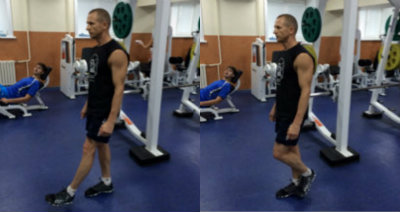 Smoothly lower yourself into a full one-legged squat until your hamstring touches your calf. The foot of the working leg should be solidly planted. The torso is leaning forward. Stretch your arms forward to maintain balance. Keep your airborne leg straight and make sure it does not touch the ground.
Smoothly lower yourself into a full one-legged squat until your hamstring touches your calf. The foot of the working leg should be solidly planted. The torso is leaning forward. Stretch your arms forward to maintain balance. Keep your airborne leg straight and make sure it does not touch the ground.
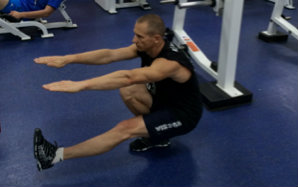 Stand up using the power of the loaded leg and keeping the free leg straight and off the floor. It is absolutely counter-indicated to drop into the squat and rebound using the elastic properties of your muscles and connective tissues rather than your strength. This could lead to serious knee injuries. So control the descent, keeping the loaded leg under tension. You may relax it briefly only when you are standing up between reps.
Stand up using the power of the loaded leg and keeping the free leg straight and off the floor. It is absolutely counter-indicated to drop into the squat and rebound using the elastic properties of your muscles and connective tissues rather than your strength. This could lead to serious knee injuries. So control the descent, keeping the loaded leg under tension. You may relax it briefly only when you are standing up between reps.
How to Build Up to a Pistol
Box Pistol
Start with a box or platform that puts your knee at ninety degrees of flexion when you are sitting on it:
Progressively reduce the box height:
Finally do the rocking pistol off the floor:
Gymnastic Rings or TRX Assisted Pistol
The longer are the straps, the less you can help yourself with your arms.
Rubber Band Assisted Pistol
I consider this the safest method, as the amount of assistance you receive from the band(s) increases as you descend into the squat and reaches its peak on the bottom. This maximally reduces the risk of injuries.
The amount of assistance is regulated by the band’s or bands’ strength, length, height of attachment. Holding on with one arm is harder than with two.
Pulley Assisted Pistol
The more weight you place on the stack, the more help you get. As with bands, you may use two pulleys (easier) or one (harder).
Stationary Support Assisted Pistol
Progress from holding on to a stationary object or objects with both hands to holding with one hand, and then to holding on to a wall. The next step is the standard pistol.
Pistol Training for Limited Flexibility
Often a lack of flexibility, especially in the ankle, is the limiting factor in achieving a pistol. An effective corrective exercise is relaxing in the bottom position of a one-legged calf raise, with or without extra weight.
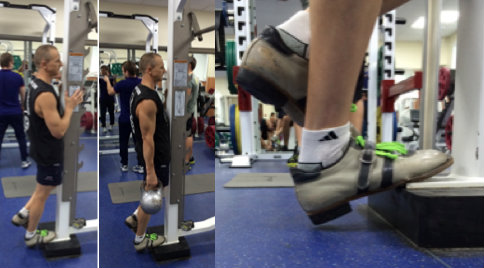 Until you have built up sufficient ankle flexibility you may practice your pistols with your heel elevated on a board or small barbell plate.
Until you have built up sufficient ankle flexibility you may practice your pistols with your heel elevated on a board or small barbell plate.
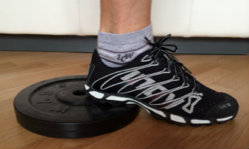 Inadequate flexibility of the lower back and hamstrings prevents one from holding the free leg straight in front. Various forward bends, with and without weight can be recommended as correctives.
Inadequate flexibility of the lower back and hamstrings prevents one from holding the free leg straight in front. Various forward bends, with and without weight can be recommended as correctives.
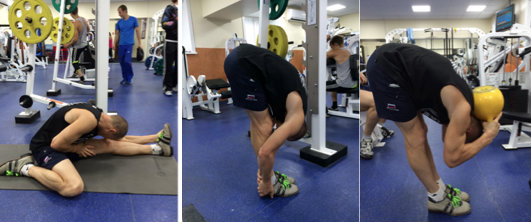 If you have plenty of strength but are lacking in flexibility, do your one-legged squats standing on a box. Start with a box tall enough to allow your free leg to go straight down without touching the floor. Progressively reduce the box height.
If you have plenty of strength but are lacking in flexibility, do your one-legged squats standing on a box. Start with a box tall enough to allow your free leg to go straight down without touching the floor. Progressively reduce the box height.
Weighted Pistol
The next step is a pistol with added weight. Do not attempt it until you are able to do 20+20 reps in a minute. The simplest, and the easiest when it comes to balance, way to load the pistol is by holding a light weight in front of you, like two light dumbbells or a kettlebell.
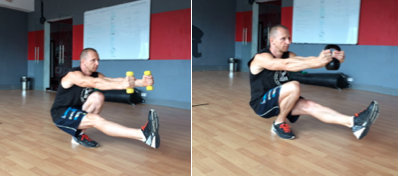 As the weight gets heavier, bend your arms and hold it closer to your body and lower.
As the weight gets heavier, bend your arms and hold it closer to your body and lower.
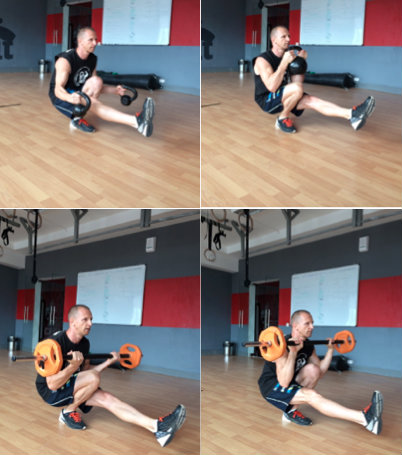 A kettlebell or a pair of kettlebells may be racked.
A kettlebell or a pair of kettlebells may be racked.
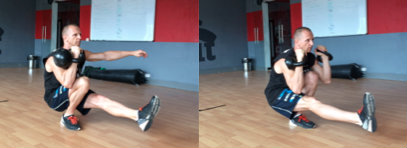 A weighted pistol may be done by itself or in complex with some other exercise(s), e.g. the deck pistol with a front raise:
A weighted pistol may be done by itself or in complex with some other exercise(s), e.g. the deck pistol with a front raise:
A heavier weight is better to hold on your back (a barbell) or on your trapezius (a kettlebell). The down side of this method is it makes it difficult to keep the free leg straight and to prevent it from touching the ground.
The most challenging, when it comes to flexibility and coordination, type of a pistol is the overhead pistol.
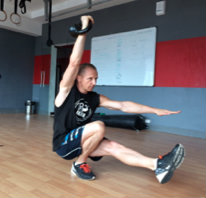 From 20+20 to 100+100 Pistols
From 20+20 to 100+100 Pistols
I went through this program together with three of my students. We started in January
2013 and finished in May. Note that the pistol was not our main event but an addition to our kettlebell training.
We included pistols into our training sessions three times a week, on Mondays, Wednesdays, and Fridays. Mondays were “control sessions” made up of one long set that was gradually approaching our goal.
|
Monday # |
Training Session |
| 1. |
(5+5)х10=100 |
| 2. |
30+30=60 |
| 3. |
(7+7)х10=140 |
| 4. |
35+35=70 |
| 5. |
(10+10)х10=200 |
| 6. |
40+40=80 |
| 7. |
(13+13)х8=208 |
| 8. |
45+45=90 |
| 9. |
(17+17)х6=204 |
| 10. | |
| 11. | |
| 12. |
55+55=110 |
| 13. |
(25+25)х4=200 |
| 14. |
65+65=130 |
| 15. |
(34+34)х3=204 |
| 16. |
75+75=150 |
| 17. |
One of us completed the seventeen-week plan in nineteen weeks, the rest in twenty. The delays were explained by injuries, work, and family. I must stress that none of us got injured performing pistols.
Although all of us made the planned Monday sessions on the first attempt, it might happen that you do not. In that case, just take a step back and continue. E.g., if you did not make the numbers on session number ten, next Monday go back to session number nine and keep going.
Wednesday and Friday sessions were secondary. Usually we included pistols into a circuit:
Note that the technique of a high-rep pistol differs from that of a classic pistol. The free leg may be bent and it may move somewhat to the side rather than strictly forward.
Breathing deserves special attention. When you are doing 100+100 pistols, you are no longer performing a strength exercise but an endurance one. For instance, my set lasted 13:50. Any cyclical aerobic work creates a demand for a lot of oxygen. Hence breathing must be uninterrupted, smooth, and rhythmical. I recommend the following:
• Inhale-exhale on descent
• Inhale-exhale on ascent
• If needed, one or more extra breathing cycles standing between reps
I will be glad if my plan helps some people. If you give it a shot, I wish you luck!
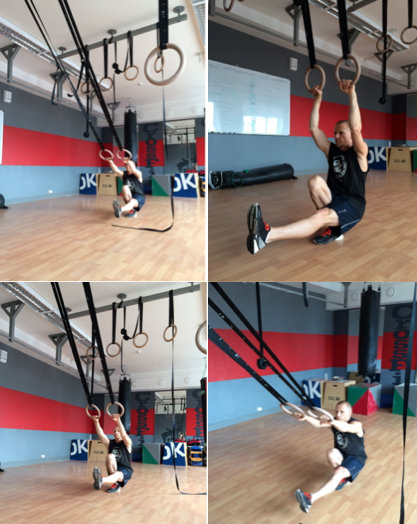
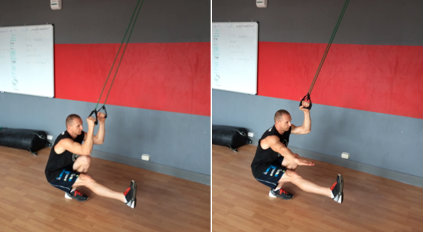
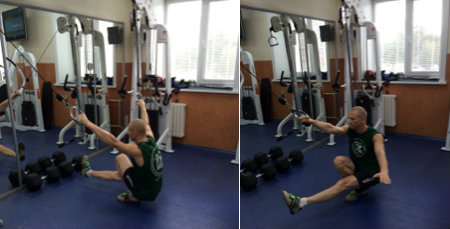
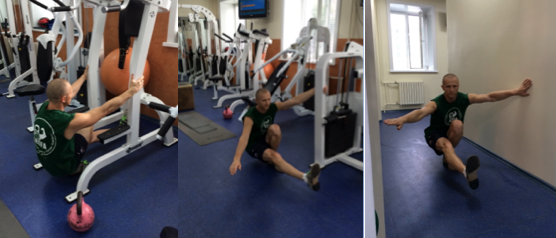
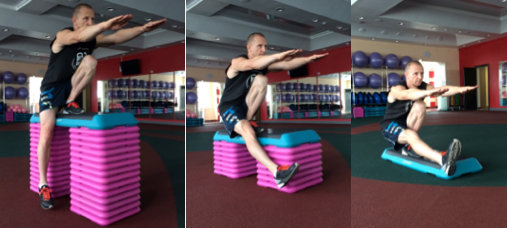
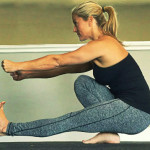
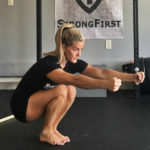
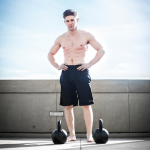
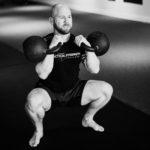

What should the reps and sets be for the early progressions? also how many reps should I be able to perform before I move on to the next progression?
Wonderful article, I’ve been thinking about how I might get pistols recently. A few would be nice, even only 5 x 5.
The adjustable height platform for the the rocking pistol is a bit expensive. I’m thinking of getting ten 12″x12″ pavers at about a buck apiece and stacking them. Has anybody tried this? It might be a little unstable unless one were very careful.
I’ve used boards and cinder blocks for years as steps for various progressions. Cheap, durable. No reason not to.
I accomplished my first successful round of pistols after reading this; they’ve gotten better every day. Looking forward to attempting some of the variations, once I’m able!
I should start by saying it’s amazing that anyone can do even one of these! Then my question: Why would you bother? Don’t 99% of people exercise by doing regular two legged squats? I tend to think more are likely to get injured trying this, though I’m sure there are amazing people who don’t. I’ll be a spectator in awe.
Pistols are a great way to improve dynamic hip, knee and ankle stability. One legged work is beneficial because RS-LS asymmetries in strength will show up and can be addressed. A lot of the people who only do barbell squats will have some asymmetry because we all have a dominant side and a barbell doesn’t address it. If you look at an FMS screen, you’ll see that asymmetries are the first to be corrected to help prevent future injury.
Thanks for an incredibly comprehensive and helpful tutorial on pistols! Can’t wait to try some of the suggestions out. Great article.
Excellent and motivating information. Ever since I read “The Naked Warrior” almost a decade ago, I have been struggling with the mighty pistol! As a skinny, long-femured dude, pistols do not come easily to me. I can only do about 5 reps/leg. This article mentions an idea that I have been using recently to increase my rep count: Using gymnastics rings for assistance. This technique works well for me since leg strength and leverage, rather than balance, are my limiting factors. However, the concept of using elastic bands as an aid is outstanding! I will be implementing this information. Thanks Sergey!
Fantastic. Bound to become a frequently cited article.
I can’t believe no one has commented on this yet. Sergey, this is fantastic! I’m a big fan of pistols and I’m absolutely going to give this program a shot.
Thanks for the incredible idea and the solid program to go with it!